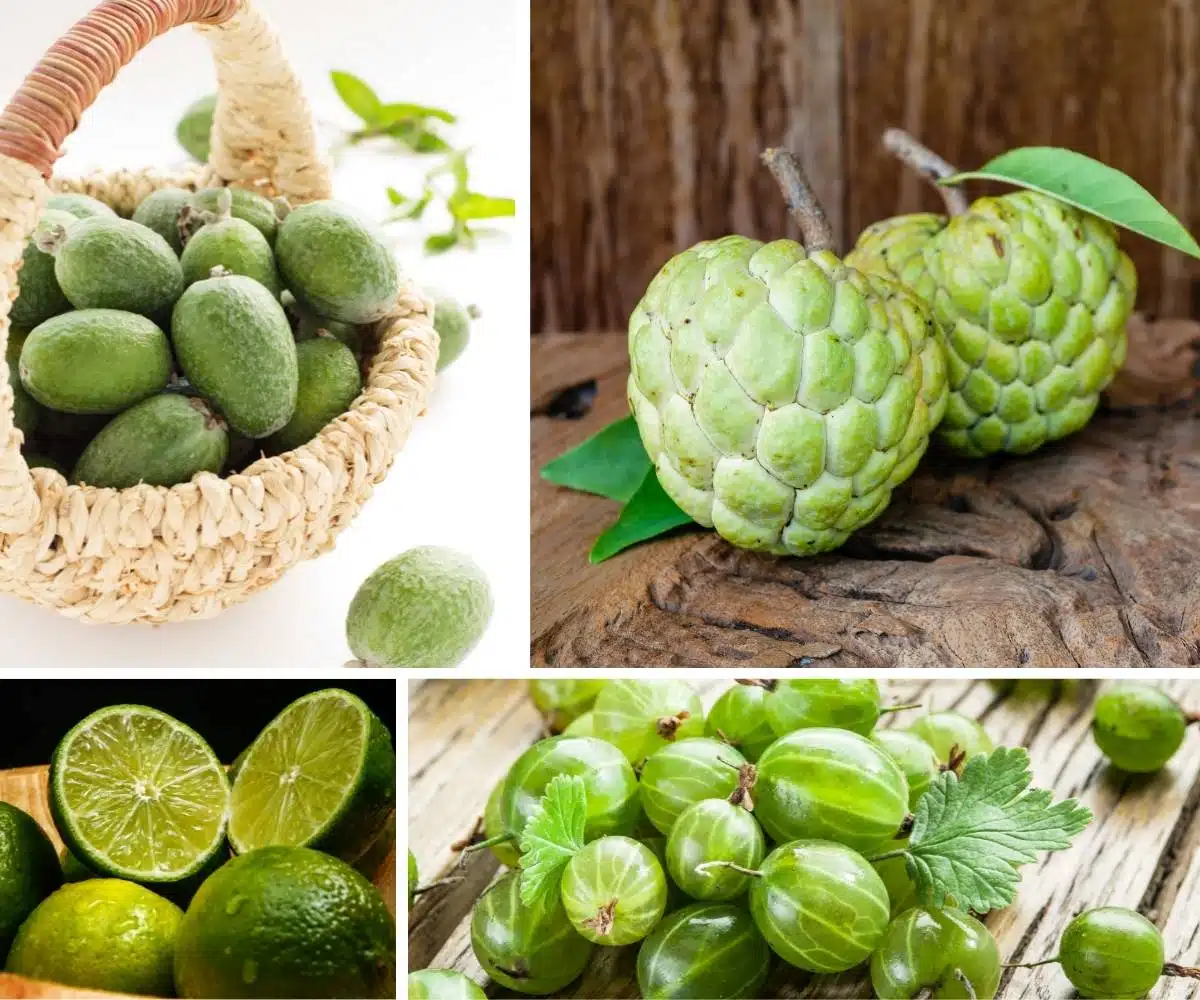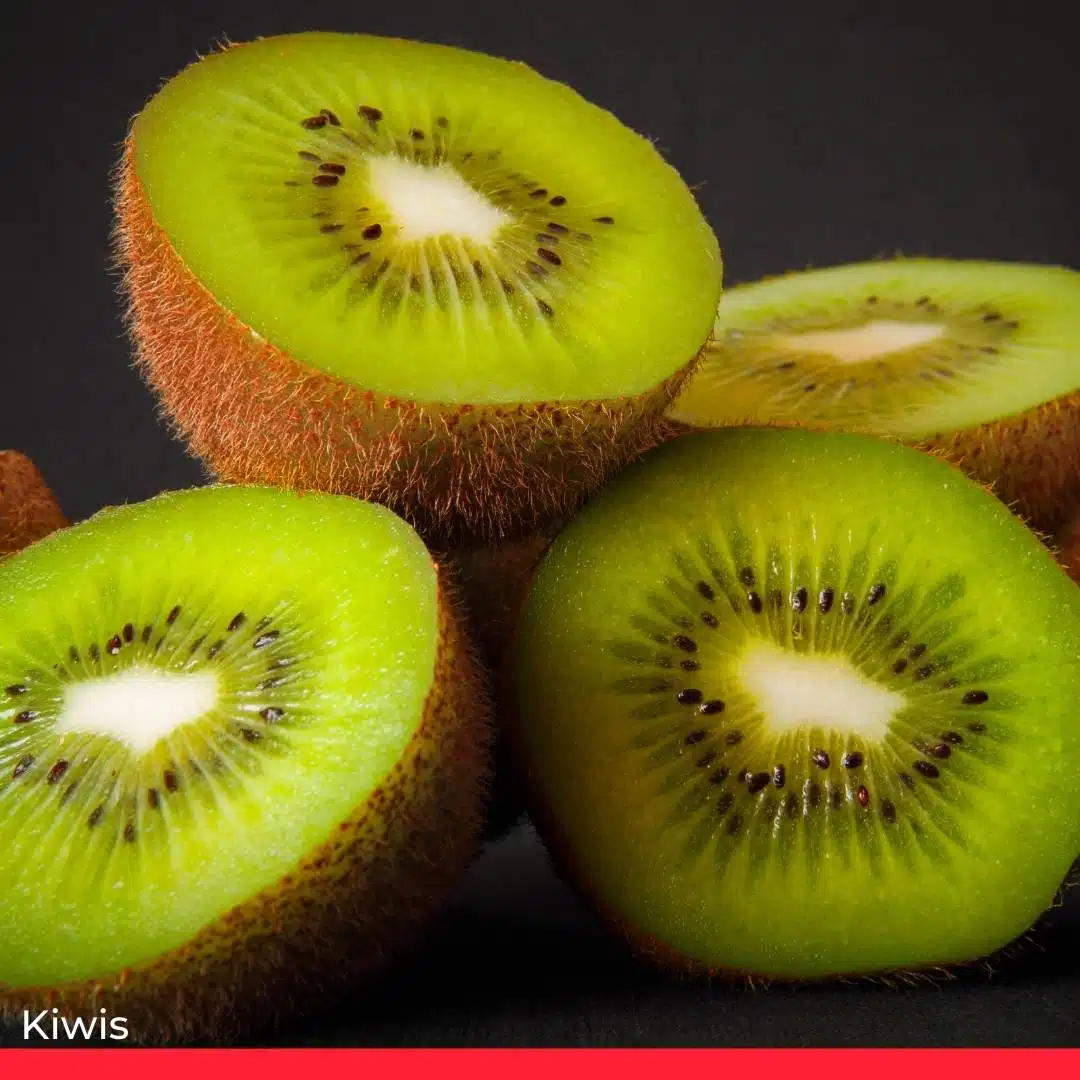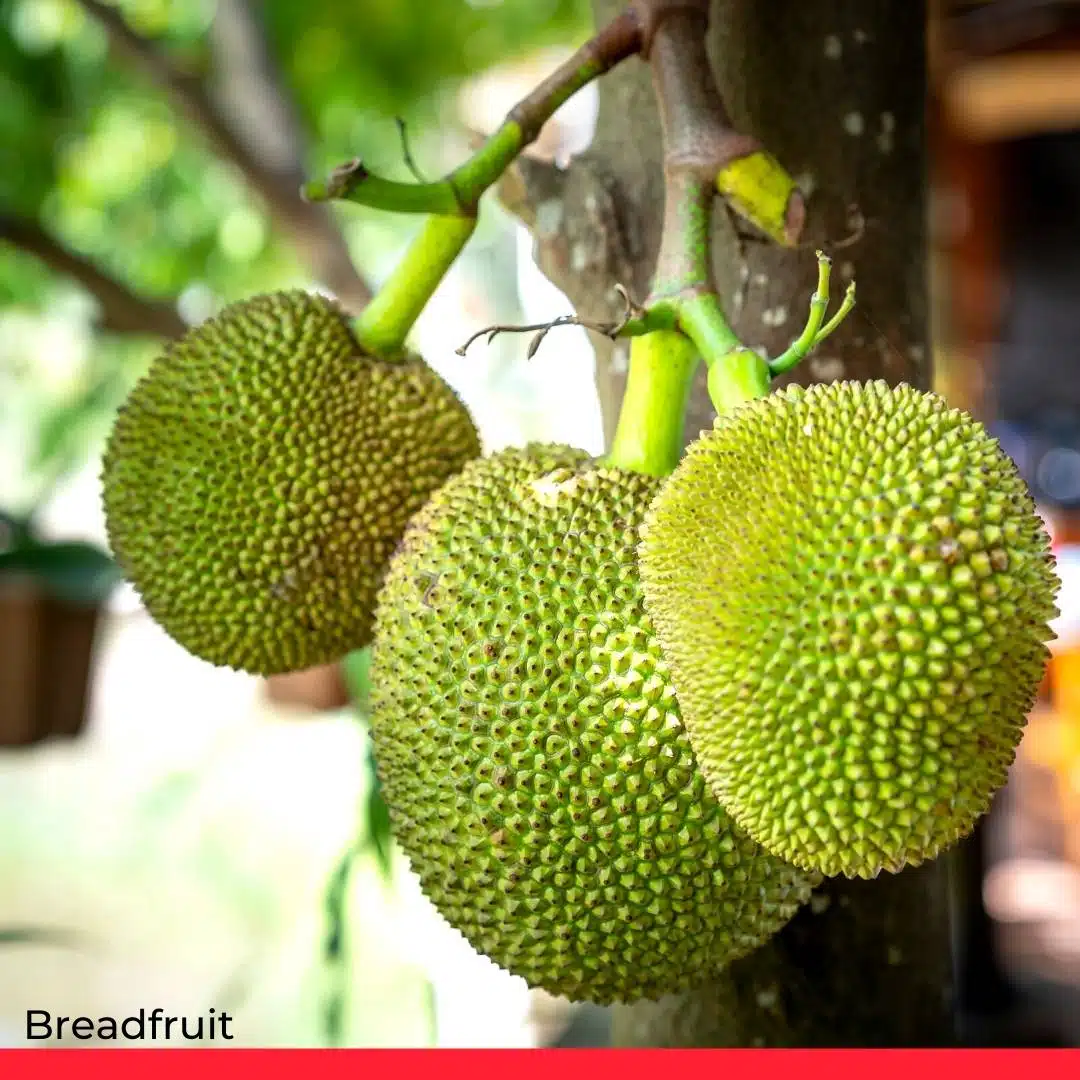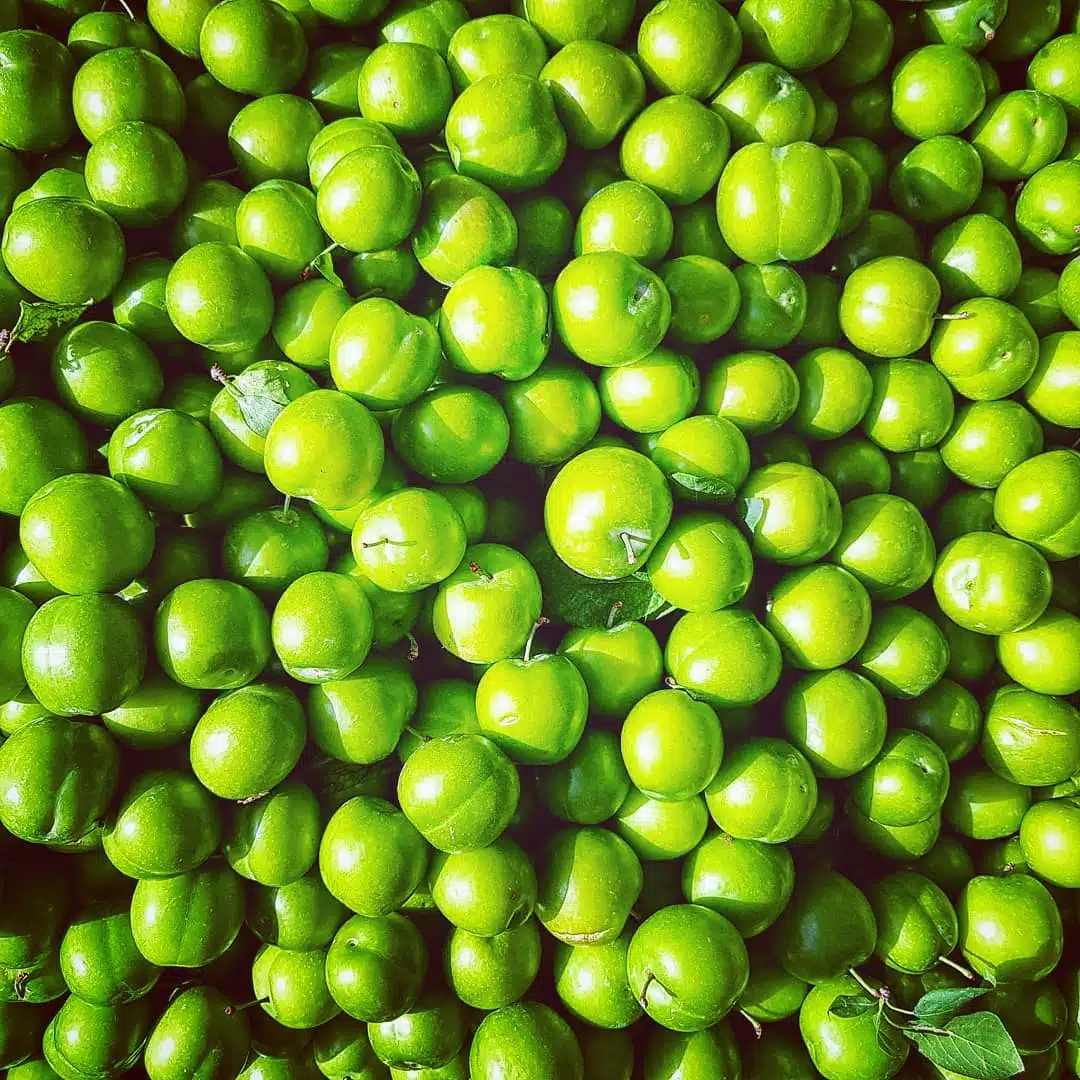Add These 21 Green Fruits To Your Diet

Nothing symbolizes freshness and health like the color green. Green fruits are not only delicious but they’re also loaded with health-giving nutrients.
So if you’re looking to introduce some new green fruits to your fruit bowl or your recipes, check out our list of 20 that we love, and you may find something new to look for next time you’re fruit shopping!
1. Kiwis

Nothing says ‘I’m healthy’ more than the vibrant green flesh of kiwi fruit, studded with tiny black seeds and glistening with juice. Sweet and sharp, kiwis are a delicious addition to fruit salads or breakfast cereals. Or mix them into smoothies, or perhaps combine them with lime and mint for the ultimate summer refresher.
Kiwis make a valuable contribution to any healthy diet. They contain as much potassium as bananas, more vitamin C than oranges, and twice as much vitamin E as avocados.
2. Green Apples

The bright green skin of the world’s most popular fruit hides the luscious, juicy white flesh inside. There are plenty of green apples to choose from, including Crispins, Shizukas, and Pippins, each with a distinctive taste.
Sour Granny Smiths are perhaps the most versatile cooking apple. They retain their texture even when baked. Their flavor is enhanced when contrasted with sweeter fruits, such as blueberries, in pies and crumbles.
Green apples contain the prebiotic pectin, which promotes healthy digestion. They also provide valuable amounts of vitamins A and C, calcium, and iron.
3. Limes

Although many believe that lemons and limes are interchangeable, limes are unequaled when providing a strong, sour, acidic punch (for example, in margaritas!).
If you get the chance to sample one, Australian finger limes are astonishing. Cut open the uninteresting exterior, and hundreds of tiny emerald beads, each packed with mouth-watering juice, tumble out.
And even more delightful – when you place them on your tongue, they explode, releasing their intense citrus punch. This unique experience is why they’re sometimes called ‘lime caviar’.
4. Gooseberries

These sour little green gems make perfect partners for sweet crumbles and hot desserts. In addition, gooseberries are exceptionally versatile and can be used in fools, mousses, ice creams, and jellies.
They also make fantastic chutneys and sharp, acidic sauces for rich meats such as pork and duck.
In addition to vitamins A and C, gooseberries contain valuable quantities of manganese, which has a range of health benefits and is thought to help with premenstrual syndrome.
5. Breadfruit

This tropical fruit, which can measure up to 12 inches in diameter, is covered with a bumpy green leathery skin, which turns brown as the fruit matures. The soft, pale flesh has a mild flavor that resembles potatoes.
You can use breadfruit like other starchy vegetables – steam, boil, fry, bake, or in fritters and pancakes. A staple in many countries, you can also include it in curries and stews.
Nutritionally, breadfruit is a superfood. The white flesh provides B complex vitamins and vitamins E, C, and K. It also contains a wide range of minerals, including potassium.
6. Sempedak

Sempedaks are large fruits with thin green leathery skin that’s dotted with geometric shapes.
The arils (fleshy segments) can be eaten raw or added to stews and curries. While the arils are sweet and slimy, the flavor resembles jackfruits and durians. They also have a strong odor reminiscent of durians, which people love or hate.
It’s high in vitamins B,C, and fiber so it is a worthwhile addition to a balanced diet.
7. Chayote

Chayote is an exotic fruit that resembles a wrinkled avocado or pear. It has a mild flavor and texture resembling something between a cucumber and a potato, so it’s rarely eaten raw. However, it can be marinated in lemon or lime juice and grated for use in salads.
If you come across chayote and experiment with this unusual ingredient, it’s a valuable source of dietary fiber, vitamins C, B2, B5, B6, and B9, as well as potassium, copper, manganese, magnesium, and phosphorus.
8. Custard Apple

This strange and wonderful fruit, also known as a cherimoya, sitaphal, or sugar apple, is nothing like an apple. It’s a rounded cone shape, with skin that resembles reptile scales and dissolves easily.
The creamy flesh inside is delicious and fragrant. However, it’s also packed with large black seeds, which are inedible as they contain toxins. It’s time-consuming to pick them out, but you can eat and spit if you fancy that.
Custard apples contain a wide range of vitamins, minerals, and a helpful amount of dietary fiber.
9. Durian

Love them or hate them. Some people love the fragrance of durians, while others compare it to rotting onions (or worse). While the jury is out, just don’t try to take them on public transport.
Once you break through the tough, spiky green skin, you’ll find red or orange arils nestled into creamy white flesh. These are sweet and creamy though somewhat rich.
The pulp is a fantastic source of vitamins A and C, B-complex vitamins, and a range of minerals.
10. Feijoa

This green New Zealand native, also known as pineapple guava, is an apple-sized fruit with smooth skin. It tastes like a cross between a pineapple, a quince, and a lemon when fully ripe. Some people detect a hint of eucalyptus. The texture is slightly gritty, similar to a pear, and they have a powerful floral aroma.
This versatile fruit can be added to fresh fruit salads, blended to make a sorbet, or used as an accompaniment for roasted meats. Feijoa is a rich vitamin C, potassium, and dietary fiber source.
11. Green Mangoes

As a dietary staple across Asia, where it’s often called ‘the king of fruits’, this succulent green fruit is found everywhere in sweets, ice cream, and juices. The firm, juicy flesh delivers a perfect balance of sour-sweet flavor. It’s enjoyed raw or incorporated into savory dishes to provide contrast.
Green mango is high in vitamins C and B and contains beneficial digestive enzymes.
12. Greengage Plums

The thin skin of greengage plums is dusted with a characteristic whitish coat. Bite into one and savor the sweet-sharp flavor, which some people compare to strawberries.
Greengages are typically used in sweet dishes and preserves and partner well with sweeter fruits such as apricots.
A single medium-sized greengage plum contains a recommended daily amount of beneficial dietary fiber and around 36 calories.
13. Green Star Fruit

The best time to enjoy star fruit is while it’s yellow, with small green splashes on the skin. Before it reaches peak maturity, star fruit isn’t massively sweet. But take a bit and enjoy the crunchy texture, bursting with a refreshing juice.
This strikingly-shaped fruit makes an unusual partner for fish and poultry dishes. Or use it instead of lemon or lime slices to garnish cocktails and juices.
Starfruit is an excellent source of vitamins and other nutrients, as well as antioxidants
14. Jackfruit

Jackfruit is the world’s largest tree-borne fruit. It’s usually used when unripe, as its neutral taste goes well with both meat-based and vegetarian dishes. In addition, the fibrous flesh even makes a vegan substitute for chicken or pulled pork.
The taste of ripe jackfruit is similar to other tropical fruits such as bananas, mangoes, or pineapples. It can be used to make healthy desserts or smoothies.
Jackfruit is a valuable source of B-complex vitamins, calcium, magnesium, potassium, and phosphorus.
15. Marang

Native to the Philippines, this exotic fruit looks like a giant hedgehog. The flavor has been compared to pears, berries, bananas, jackfruits, and pineapples.
What’s not to like? Well, the aroma is often compared to gasoline, which is frankly weird. Nevertheless, some people are addicted to it, in the same way that some people love smelly cheeses. The roasted seeds have a texture that’s a cross between potatoes and chestnuts.
Marang contains a full house of nutrients: vitamins A, B, and C, dietary fiber, and a broad spectrum of minerals, including zinc, iron, phosphorus, protein, potassium, calcium, manganese, copper, and magnesium.
16. Green Anjou Pears

Green Anjou pears are bright green and sometimes have a subtle red blush.
They’re incredibly versatile. Succulent and bursting with juice when ripe, they’re sweet with perhaps a hint of lime. Their firm flesh retains its texture when baked, poached, roasted, or grilled. They partner exquisitely with cheese. Green Anjous make the perfect daily treat, sliced fresh in salads or eaten as a low-calorie snack.
There are around 100 calories in a medium-sized pear. Yet, they contain 21% of the daily recommended amount of fiber, 8% of vitamin C, and 4% of potassium.
17. Persian Limes

Persian limes, smaller than more common varieties, are usually seedless. The light green pulp is not as sharp or aromatic as key lime, although it can be used interchangeably. It makes terrific juices, cocktails, and iced teas.
Like all limes, Persian limes are a rich source of vitamins A and C, plus a range of valuable minerals.
18. Persian Sour Plums

These small plums have taut, shiny flesh that’s a vibrant green. Inside, the flesh is pale greed. When picked young, these plums are prized for their sharp, sour flavor with notes of green apples or lemons.
They’re refreshing when eaten raw or sliced as an appetizer, perhaps with salt and chili. Or they can be added to any number of stews and casseroles and feature in Turkish, Lebanese, Iranian, and Moroccan cuisine.
In addition to their delicious flavor, they are a valuable source of vitamins A, C, and K.
19. Soursop

Soursop is an irregularly shaped tropical fruit covered in pliable green spines reaching up to twelve inches long. It has a delicious aroma and a sweet, slightly acidic flavor reminiscent of other tropical delights such as bananas, coconuts, mangoes, or pineapples.
They’re lovely to cut in half and eat with a spoon, discarding the inedible seeds. They’re used to create a wide range of desserts or mixed into smoothies.
In addition to the specific vitamins and minerals found in green fruits, soursops are rich in antioxidants, which protect the body against free-radical damage and help to reduce inflammation.
20. Green Grapes

There are so many green grape varieties it’s easy to find the one that suits you best. The most popular worldwide is Thompson’s Seedless, which has a sweet-sour taste profile. As the name suggests, they solve the ‘what to do with the seeds’ dilemma when snacking.
Newer varieties, such as Cotton Candy or Sugarone, are sweeter. However, Muscat grapes, the oldest known variety, with their unbelievable floral fragrance and unparalleled juiciness, are hard to beat.
Although green grapes contain fewer antioxidants than red ones, they are loaded with potassium and fiber to help regulate cardiovascular health.
21. Monstera Deliciosa
This rare fruit has been creating a buzz on social media lately because when ripe it can be eaten like green corn-on-the-cob.
The kernels are soft and juicy, with a texture similar to that of pineapple or mango, and the fruit has a honeyed, tropical fragrance.
Monstera fruits are a natural laxative. They’re a rich source of potassium, which balances the body’s fluid levels, and contain vitamin C, which strengthens the immune system and boosts the skin’s collagen production.
Tastes amazing and reduces wrinkles! What’s not to like?
Related: 25 Naturally Green Foods

Related: 20 Healthy Orange Fruits

Related: 19 Stunning Blue Fruits

Related: 20 Naturally Black Fruits


